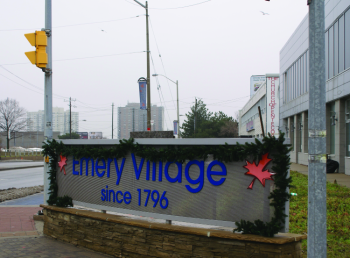
An extraordinary chronicle of our Business Improvement Area
By Tm LambrinosIn 1948, the Township of North York announced groundwork for a 50 year Official Plan that shaped and rezoned nearly all of the land around Finch and Weston, proudly referred to as Emery at the time.
The land was operated by farmers Plunkett, Rowntree, McClure and Devins, to name a few.
In 1955, Camillo Milani took advantage of the rezoning and began setting up his vision to create the largest industrial complex in Canadian history. His venture was initially approved by the township and involved 1,000 acres encompassing all lands north of Finch to Steeles, from Islington to Weston Road. Milani later amended his grand plan to rezone a residential neighbourhood around modern-day Gracedale. Milani built factories and buried much of the existing Emery Creek that ran through the new industrial area in order to allow storm water runoff on newly built factory roads. The sewers for these industrial streets were installed at the time of the building of the factories with storm water drainage into the underground creek.
In 1995, Bob Chabot operated Centennial Sweeping located at 143 Toryork Drive - right in the heart of Emery’s industrial area. The company was well established utilizing large trucks to clean streets and other spills. At the time, the City of North York identified a higher-than-average pollution problem for the underground Emery Creek that undoubtedly derived from the surrounding industrial area. This storm water runoff system was found to have significantly higher levels of pollutants that were draining into the Humber River via the Emery Creek. Bob Chabot and his daughter Lorraine founded the Emery Creek Environmental Association to implement education for factory owners and help keep the area’s storm water runoff and the Emery Creek, clean.

Around the same time, Councillor Giorgio Mammoliti envisioned exciting new plans for the redevelopment of the Finch and Weston Road intersection. City staff at the time recommended that a business improvement area be formed in order to create a brand-new secondary plan for the community.
In 1997, after reviewing a historical study, Mammoliti chose the new BIA to be named Emery Village instead of Finch-West Village, as city planners had recommended.
In November 2002, the North York community council approved the Emery Village Secondary Plan which involved improvements for various amenities.
Bob Chabot and his daughter Lorraine were already well-known and were asked to set up as the anchor-point for the new BIA from their existing environmental organization.
In 2003, Lorraine Chabot appeared at a meeting of the Ontario Municipal Board that permitted a new BIA to be formed with her serving as the first Chair of the Board. 
And in that year, the Emery Village BIA was officially adopted by Toronto City Council with visions to assist beautifying and making the area more attractive for businesses, among other things. The notion to commemorate the history of prominent persons of Emery by using historical markers has been in the grander vision since day-one. Heritage was importantly adopted into the city’s secondary plan for the area, as well.
The Emery Village BIA can now boast being the biggest business improvement area in the country with a specific emphasis on pride for national patriotism.
Today, the BIA has undergone further border expansion and is currently reviewing new and exciting master plans for appropriate naming, branding, signs and markers for Emery’s wide-ranging and ever-changing industrial core and retail businesses.













